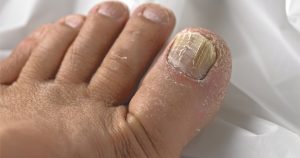By Dr. Isin Mustafa, DPM, MSHS, DABPM, FACPM
 It’s September, but Thanksgiving and Christmas are just around the corner. The holidays will provide some good time and food with your coworker, friends, and family. So, when you slide your feet into your new pair of heels, are you going to be mortified to see your toenails are thick and discolored?
It’s September, but Thanksgiving and Christmas are just around the corner. The holidays will provide some good time and food with your coworker, friends, and family. So, when you slide your feet into your new pair of heels, are you going to be mortified to see your toenails are thick and discolored?
Most commonly, these changes are due to an infection of the nail caused by a fungus. Nail fungus can be difficult to treat, therefore the sooner you begin treatment the better chance you have of eradicating the fungus. Once the nail fungus has been present for an extended period of time, it is much more difficult to treat. Nail fungus, also referred to as onychomycosis, is an infection underneath the surface of the nail caused by fungi or yeast. When the fungi take hold, the nail becomes darker, debris can collect under the nail, and white discoloration may appear. Over time, the affected nails become very thick and difficult to trim. The fungus can even spread to adjacent nails.
You may have been exposed to the fungi when walking around damp areas barefoot like swimming pools, locker rooms, and showers. Injury to the nail bed, even pressure from shoes, will make it more susceptible to the fungi. Anyone can be affected but people with chronic diseases, such as diabetes, circulatory problems, or immune-deficiency conditions, are especially prone to developing a fungal nail infection.
Other contributing factors may be a history of athlete’s foot and excessive perspiration. Treatment can take months to a year to completely clear the fungus. Your healthcare provider will discuss treatments options with you to determine what the best option is for you. Unfortunately, recurrence is common. For these reasons, prevention is key. Proper hygiene and performing daily foot exams including your toes are the first line of defense. Clean and dry feet can better resist infection by the fungus.
Tips to help you avoid nail fungus.
. Never go barefoot.
. Wear flip flops or shower shoes in public areas.
For example, at public showers at the pool or gym.
Walking around a public pool.
. Wash your feet with soap and water daily. Make sure to thoroughly dry your feet after washing, including between your toes. You may even want to wash your feet after the gym or going to a public pool.
. Disinfect your shoes with an Over-The-Counter antifungal sprays or powders.
. Wear moisture wicking and breathable socks.
Socks made of synthetic fibers that wick moisture away from your feet are recommended. If your feet perspire, then you should change your socks throughout the day. Don’t share shoes or socks with others. Change your socks after exercise. You may also alternate gym shoes to allow the material to dry completely.
. Don’t share clippers or foot products with other people. Disinfect instruments use to cut your nails and other pedicure tools.
. Treat athletes’ foot if present.
. Avoid tight fitting shoes and use shoes made with breathable material.
. If signs of nail fungus are present, avoid nail polish.
. Keep nails trimmed and clean. Nails should be at the same length as the tip of the toe.
. Wash your shoes, this includes hiking boots to sandals. Shoes that haven’t been cleaned are a great place for fungus to thrive.
For more information about preventing or treating nail fungus contact your local foot and ankle specialist.
Disclaimer: This content is not intended to be a substitute for professional medical advice, diagnosis, or treatment. Always seek the advice of your physician or other qualified health care provider with any questions you may have regarding a medical condition.
Isin Mustafa, DPM, MSHS, DABPM, FACPM
Isin Mustafa, DPM, is a Podiatrist at Family Foot & Leg Centers in Port Charlotte, FL. She is a Fellow of the American College of Foot & Ankle Surgeons. Call 239-430-3668 or visit www.NaplesPodiatrist.com to make an appointment. Visit FootHealthFacts.org to learn more about foot and ankle conditions.









